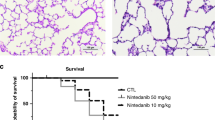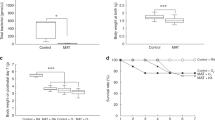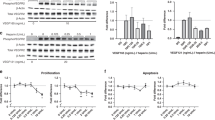Abstract
We have shown that vitamin A (VA) and retinoic acid (RA) synergistically increase lung retinyl ester content in neonatal rats. To confirm whether this biochemical synergism attenuates early neonatal hyperoxic lung injury in mice, we exposed newborn C57BL/6 mice to 95% O2 or air from birth to 4 d. The agent [vehicle, VA, RA, or the combination vitamin A + retinoic acid (VARA)] was given orally daily. Lung and liver retinyl ester content was measured, and lung injury and development were evaluated. We observed that lung, but not liver, retinyl ester levels were increased more by VARA than by VA or RA alone. Hyperoxic lung injury was reduced by VA and RA, and more so by VARA. VARA attenuated the hyperoxia-induced increases in macrophage inflammatory protein (MIP)-2 mRNA and protein expression, but did not alter hyperoxia-induced effects on peptide growth factors (PDGF, VEGF, and TGF-β1). The 4-d exposure to hyperoxia or retinoids did not lead to observable differences in lung development. We conclude that the VARA combination has synergistic effects on lung retinyl ester concentrations and on the attenuation of hyperoxia-induced lung injury in newborn mice, possibly by modulation of inflammatory mediators.
Similar content being viewed by others
Log in or create a free account to read this content
Gain free access to this article, as well as selected content from this journal and more on nature.com
or
Abbreviations
- BALF:
-
bronchoalveolar lavage fluid
- BPD:
-
bronchopulmonary dysplasia
- MIP:
-
macrophage inflammatory protein
- MCP:
-
onocyte chemoattractant protein
- RA:
-
retinoic acid
- RANTES:
-
regulated upon Activation, normal T-cell expressed, and secreted
- RE:
-
retinyl esters
- VA:
-
vitamin A
- VARA:
-
vitamin A + retinoic acid
References
Ambalavanan N, Carlo WA 2004 Bronchopulmonary dysplasia: new insights. Clin Perinatol 31: 613–628
Shenai JP, Chytil F, Stahlman MT 1985 Vitamin A status of neonates with bronchopulmonary dysplasia. Pediatr Res 19: 185–188
Darlow BA, Graham PJ 2007 Vitamin A supplementation to prevent mortality and short and long-term morbidity in very low birthweight infants. Cochrane Database Syst Rev 4: CD000501
Tyson JE, Wright LL, Oh W, Kennedy KA, Mele L, Ehrenkranz RA, Stoll BJ, Lemons JA, Stevenson DK, Bauer CR, Korones SB, Fanaroff AA 1999 Vitamin A supplementation for extremely-low-birth-weight infants. N Engl J Med 340: 1962–1968
Ambalavanan N, Ross AC, Carlo WA 2005 Retinol-binding protein, transthyretin, and C-reactive protein in extremely low birth weight (ELBW) infants. J Perinatol 25: 714–719
Chailley-Heu B, Chelly N, Lelievre-Pegorier M, Barlier-Mur AM, Merlet-Benichou C, Bourbon JR 1999 Mild vitamin A deficiency delays fetal lung maturation in the rat. Am J Respir Cell Mol Biol 21: 89–96
Massaro D, Massaro GD 2003 Retinoids, alveolus formation, and alveolar deficiency: clinical implications. Am J Respir Cell Mol Biol 28: 271–274
Couroucli XI, Liang YW, Jiang W, Barrios R, Moorthy B 2006 Attenuation of oxygen-induced abnormal lung maturation in rats by retinoic acid: possible role of cytochrome P4501A enzymes. J Pharmacol Exp Ther 317: 946–954
Veness-Meehan KA, Pierce RA, Moats-Staats BM, Stiles AD 2002 Retinoic acid attenuates O2-induced inhibition of lung septation. Am J Physiol Lung Cell Mol Physiol 283: L971–L980
Ross AC, Ambalavanan N, Zolfaghari R, Li NQ 2006 Vitamin A combined with retinoic acid increases retinol uptake and lung retinyl ester formation in a synergistic manner in neonatal rats. J Lipid Res 47: 1844–1851
Ross AC, Li NQ, Wu L 2006 The components of VARA, a nutrient-metabolite of vitamin A and retinoic acid, act efficiently together and separately to increase retinyl esters in the lungs of neonatal rats. J Nutr 136: 2803–2807
Humphrey JH, Agoestina T, Wu L, Usman A, Nurachim M, Subardja D, Hidayat S, Tielsch J, West KP Jr, Sommer A 1996 Impact of neonatal vitamin A supplementation on infant morbidity and mortality. J Pediatr 128: 489–496
Massaro GD, Massaro D 1996 Postnatal treatment with retinoic acid increases the number of pulmonary alveoli in rats. Am J Physiol 270: L305–L310
Ambalavanan N, Nicola T, Hagood J, Bulger A, Serra R, Murphy-Ullrich J, Oparil S, Chen YF 2008 Transforming growth factor-beta signaling mediates hypoxia-induced pulmonary arterial remodeling and inhibition of alveolar development in newborn mouse lung. Am J Physiol Lung Cell Mol Physiol 295: L86–L95
Nicola T, Hagood JS, James ML, Macewen MW, Williams TA, Hewitt MM, Schwiebert LM, Bulger A, Oparil S, Chen YF, Ambalavanan N 2009 Loss of Thy-1 inhibits alveolar development in the newborn mouse lung. Am J Physiol Lung Cell Mol Physiol 296: L738–L750
Ambalavanan N, Carlo WA, D'Angio CT, McDonald SA, Das A, Schendel D, Thorsen P, Higgins RD, Eunice Kennedy Shriver National Institute of Child Health and Human Development Neonatal Research Network 2009 Cytokines associated with bronchopulmonary dysplasia or death in extremely low birth weight infants. Pediatrics 123: 1132–1141
Johnston CJ, Wright TW, Reed CK, Finkelstein JN 1997 Comparison of adult and newborn pulmonary cytokine mRNA expression after hyperoxia. Exp Lung Res 23: 537–552
Ben-Ari J, Makhoul IR, Dorio RJ, Buckley S, Warburton D, Walker SM 2000 Cytokine response during hyperoxia: sequential production of pulmonary tumor necrosis factor and interleukin-6 in neonatal rats. Isr Med Assoc J 2: 365–369
Guthmann F, Wissel H, Schachtrup C, Tölle A, Rüdiger M, Spener F, Rüstow B 2005 Inhibition of TNFalpha in vivo prevents hyperoxia-mediated activation of caspase 3 in type II cells. Respir Res 6: 10
Cooper JA Jr, Fuller JM, McMinn KM, Culbreth RR 1998 Modulation of monocyte chemotactic protein-1 production by hyperoxia: importance of RNA stability in control of cytokine production. Am J Respir Cell Mol Biol 18: 521–525
D'Angio CT, Johnston CJ, Wright TW, Reed CK, Finkelstein JN 1998 Chemokine mRNA alterations in newborn and adult mouse lung during acute hyperoxia. Exp Lung Res 24: 685–702
Deng H, Mason SN, Auten RL Jr 2000 Lung inflammation in hyperoxia can be prevented by antichemokine treatment in newborn rats. Am J Respir Crit Care Med 162: 2316–2323
Buch S, Han RN, Cabacungan J, Wang J, Yuan S, Belcastro R, Deimling J, Jankov R, Luo X, Lye SJ, Post M, Tanswell AK 2000 Changes in expression of platelet-derived growth factor and its receptors in the lungs of newborn rats exposed to air or 60% O(2). Pediatr Res 48: 423–433
Bhandari V, Choo-Wing R, Lee CG, Yusuf K, Nedrelow JH, Ambalavanan N, Malkus H, Homer RJ, Elias JA 2008 Developmental regulation of NO-mediated VEGF-induced effects in the lung. Am J Respir Cell Mol Biol 39: 420–430
Hosford GE, Olson DM 2003 Effects of hyperoxia on VEGF, its receptors, and HIF-2α in the newborn rat lung. Am J Physiol Lung Cell Mol Physiol 285: L161–l168
Alejandre-Alcázar MA, Kwapiszewska G, Reiss I, Amarie OV, Marsh LM, Sevilla-Pérez J, Wygrecka M, Eul B, Köbrich S, Hesse M, Schermuly RT, Seeger W, Eickelberg O, Morty RE 2007 Hyperoxia modulates TGF-beta/BMP signaling in a mouse model of bronchopulmonary dysplasia. Am J Physiol Lung Cell Mol Physiol 292: L537–L549
McGowan S, Jackson SK, Jenkins-Moore M, Dai HH, Chambon P, Snyder JM 2000 Mice bearing deletions of retinoic acid receptors demonstrate reduced lung elastin and alveolar numbers. Am J Respir Cell Mol Biol 23: 162–167
Cooney TP, Thurlbeck WM 1982 The radial alveolar count method of Emery and Mithal: a reappraisal 1; postnatal lung growth. Thorax 37: 572–579
Burri P 1997 Structural aspects of prenatal and postnatal development and growth for the lung. In: McDonald JA (ed) Lung Growth and Development. Dekker, New York, p 1–35
Thurlbeck WM 1975 Postnatal growth and development of the lung. Am Rev Respir Dis 111: 803–844
Warner BB, Stuart LA, Papes RA, Wispe JR 1998 Functional and pathological effects of prolonged hyperoxia in neonatal mice. Am J Physiol 275: L110–L117
Maden M, Hind M 2004 Retinoic acid in alveolar development, maintenance and regeneration. Philos Trans R Soc Lond B Biol Sci 359: 799–808
Chetty A, Nielsen HC 2002 Regulation of cell proliferation by insulin-like growth factor 1 in hyperoxia-exposed neonatal rat lung. Mol Genet Metab 75: 265–275
Matsuura O, Kadomatsu K, Takei Y, Uchimura K, Mimura S, Watanabe K, Muramatsu T 2002 Midkine expression is associated with postnatal development of the lungs. Cell Struct Funct 27: 109–115
Bry K, Lappalainen U 2006 Pathogenesis of bronchopulmonary dysplasia: the role of interleukin 1beta in the regulation of inflammation-mediated pulmonary retinoic acid pathways in transgenic mice. Semin Perinatol 30: 121–128
Ross AC 2005 Introduction to vitamin A: a nutritional and life cycle perspective. In: Packer L, Obermuller-Jevic U, Kraemer K, Sies H (eds) Carotenoids and Retinoids. Molecular Aspects and Health Issues. American Oil Chemists' Society Press, Champaign, IL, p 23–24
Shenai JP, Chytil F 1990 Effect of maternal vitamin-A administration on fetal lung vitamin-A stores in the perinatal rat. Biol Neonate 58: 318–325
Sue RD, Belperio JA, Burdick MD, Murray LA, Xue YY, Dy MC, Kwon JJ, Keane MP, Strieter RM 2004 CXCR2 is critical to hyperoxia-induced lung injury. J Immunol 172: 3860–3868
Nakanishi H, Sugiura T, Streisand JB, Lonning SM, Roberts JD Jr 2007 TGF-beta-neutralizing antibodies improve pulmonary alveologenesis and vasculogenesis in the injured newborn lung. Am J Physiol Lung Cell Mol Physiol 293: L151–L161
Napoli JL, Posch KP, Fiorella PD, Boerman MH 1991 Physiological occurrence, biosynthesis and metabolism of retinoic acid: evidence for roles of cellular retinol-binding protein (CRBP) and cellular retinoic acid-binding protein (CRABP) in the pathway of retinoic acid homeostasis. Biomed Pharmacother 45: 131–143
Crouse DT, Cassell GH, Waites KB, Foster JM, Cassady G 1990 Hyperoxia potentiates Ureaplasma urealyticum pneumonia in newborn mice. Infect Immun 58: 3487–3493
Author information
Authors and Affiliations
Corresponding author
Additional information
Supported by NIH R01 CA-90214 (A.C.R.), R01 HL092906 (N.A.), K08 HD-046513 (N.A.), CCRI (N.A.), Dorothy Foehr Huck funds (A.C.R.), Southern Regional Education Board (M.L.J.), and UAB Gaston Fellowship (M.L.J.).
Rights and permissions
About this article
Cite this article
James, M., Catharine Ross, A., Bulger, A. et al. Vitamin A and Retinoic Acid Act Synergistically to Increase Lung Retinyl Esters During Normoxia and Reduce Hyperoxic Lung Injury in Newborn Mice. Pediatr Res 67, 591–597 (2010). https://doi.org/10.1203/PDR.0b013e3181dbac3d
Received:
Accepted:
Issue date:
DOI: https://doi.org/10.1203/PDR.0b013e3181dbac3d
This article is cited by
-
Retinoids stored locally in the lung are required to attenuate the severity of acute lung injury in male mice
Nature Communications (2023)
-
Prolonged exposure to traffic-related particulate matter and gaseous pollutants implicate distinct molecular mechanisms of lung injury in rats
Particle and Fibre Toxicology (2021)
-
Vitamin A supplement after neonatal Streptococcus pneumoniae pneumonia inhibits the progression of experimental asthma by altering CD4+T cell subsets
Scientific Reports (2020)
-
Retinoic acid promotes primary fetal alveolar epithelial type II cell proliferation and differentiation to alveolar epithelial type I cells
In Vitro Cellular & Developmental Biology - Animal (2015)
-
Combined effects of maternal inflammation and neonatal hyperoxia on lung fibrosis and RAGE expression in newborn rats
Pediatric Research (2014)



